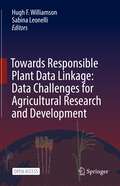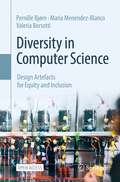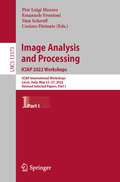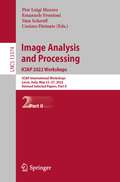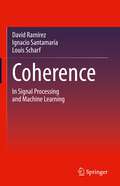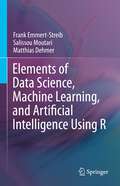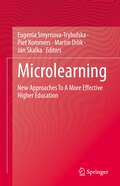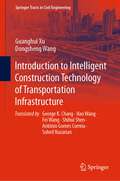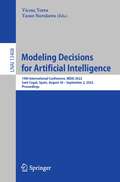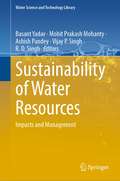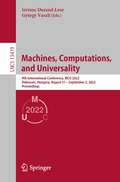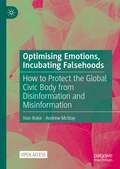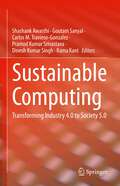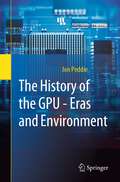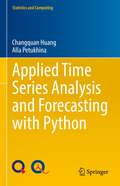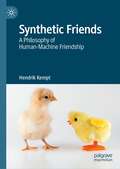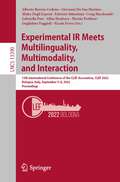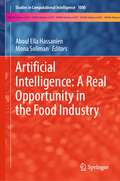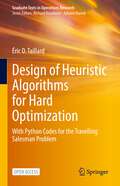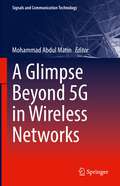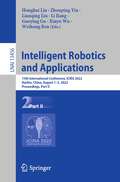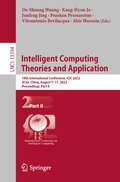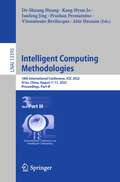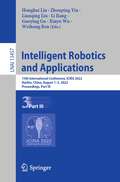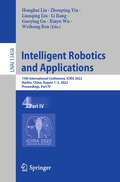- Table View
- List View
Towards Responsible Plant Data Linkage: Data Challenges for Agricultural Research and Development
by Hugh F. Williamson Sabina LeonelliThis open access book provides the first systematic overview of existing challenges and opportunities for responsible data linkage, and a cutting-edge assessment of which steps need to be taken to ensure that plant data are ethically shared and used for the benefit of ensuring global food security – one of the UN’s Sustainable Development Goals. The volume focuses on the contemporary contours of such challenges through sustained engagement with current and historical initiatives and discussion of best practices and prospective future directions for ensuring responsible plant data linkage. The volume is divided into four sections that include case studies of plant data use and linkage in the context of particular research projects, breeding programs, and historical research. It address technical challenges of data linkage in developing key tools, standards and infrastructures, and examines governance challenges of data linkage in relation to socioeconomic and environmental research and data collection. Finally, the last section addresses issues raised by new data production and linkage methods for the inclusion of agriculture’s diverse stakeholders. This book brings together leading experts in data curation, data governance and data studies from a variety of fields, including data science, plant science, agricultural research, science policy, data ethics and the philosophy, history and social studies of plant science.
Diversity in Computer Science: Design Artefacts for Equity and Inclusion
by Pernille Bjørn Maria Menendez-Blanco Valeria BorsottiThis is an open access book that covers the complete set of experiences and results of the FemTech.dk research which we have had conducted between 2016-2021 – from initiate idea to societal communication. Diversity in Computer Science: Design Artefacts for Equity and Inclusion presents and documents the principles, results, and learnings behind the research initiative FemTech.dk, which was created in 2016 and continues today as an important part of the Department of Computer Science at the University of Copenhagen’s strategic development for years to come. FemTech.dk was created in 2016 to engage with research within gender and diversity and to explore the role of gender equity as part of digital technology design and development. FemTech.dk considers how and why computer science as a field and profession in Denmark has such a distinct unbalanced gender representation in the 21st century. This book is also the story of how we (the authors) as computer science researchers embarked on a journey to engage with a new research field – equity and gender in computing – about which we had only sporadic knowledge when we began. We refer here to equity and gender in computing as a research field – but in reality, this research field is a multiplicity of entangled paths, concepts, and directions that forms important and critical insights about society, gender, politics, and infrastructures which are published in different venues and often have very different sets of criteria, values, and assumptions. Thus, part of our journey is also to learn and engage with all these different streams of research, concepts, and theoretical approaches and, through these engagements, to identify and develop our own theoretical platform, which has a foundation in our research backgrounds in Human–Computer Interaction broadly – and Interaction Design & Computer Supported Cooperative Work specifically.
Image Analysis and Processing. ICIAP 2022 Workshops: ICIAP International Workshops, Lecce, Italy, May 23–27, 2022, Revised Selected Papers, Part I (Lecture Notes in Computer Science #13373)
by Pier Luigi Mazzeo Emanuele Frontoni Stan Sclaroff Cosimo DistanteThe two-volume set LNCS 13373 and 13374 constitutes the papers of several workshops which were held in conjunction with the 21st International Conference on Image Analysis and Processing, ICIAP 2022, held in Lecce, Italy, in May 2022.The 96 revised full papers presented in the proceedings set were carefully reviewed and selected from 157 submissions.ICIAP 2022 presents the following Sixteen workshops:Volume I:GoodBrother workshop on visual intelligence for active and assisted livingParts can worth like the Whole - PART 2022Workshop on Fine Art Pattern Extraction and Recognition - FAPERWorkshop on Intelligent Systems in Human and Artificial Perception - ISHAPE 2022Artificial Intelligence and Radiomics in Computer-Aided Diagnosis - AIRCADDeep-Learning and High Performance Computing to Boost Biomedical Applications - DeepHealthVolume II: Human Behaviour Analysis for Smart City Environment Safety - HBAxSCESBinary is the new Black (and White): Recent Advances on Binary Image ProcessingArtificial Intelligence for preterm infants’ healthCare - AI-careTowards a Complete Analysis of People: From Face and Body to Clothes - T-CAPArtificial Intelligence for Digital Humanities - AI4DHMedical Transformers - MEDXFLearning in Precision Livestock Farming - LPLFWorkshop on Small-Drone Surveillance, Detection and Counteraction Techniques - WOSDETCMedical Imaging Analysis For Covid-19 - MIACOVID 2022Novel Benchmarks and Approaches for Real-World Continual Learning - CL4REAL
Image Analysis and Processing. ICIAP 2022 Workshops: ICIAP International Workshops, Lecce, Italy, May 23–27, 2022, Revised Selected Papers, Part II (Lecture Notes in Computer Science #13374)
by Cosimo Distante Pier Luigi Mazzeo Stan Sclaroff Emanuele FrontoniThe two-volume set LNCS 13373 and 13374 constitutes the papers of several workshops which were held in conjunction with the 21st International Conference on Image Analysis and Processing, ICIAP 2022, held in Lecce, Italy, in May 2022.The 96 revised full papers presented in the proceedings set were carefully reviewed and selected from 157 submissions.ICIAP 2022 presents the following Sixteen workshops:Volume I:GoodBrother workshop on visual intelligence for active and assisted livingParts can worth like the Whole - PART 2022Workshop on Fine Art Pattern Extraction and Recognition - FAPERWorkshop on Intelligent Systems in Human and Artificial Perception - ISHAPE 2022Artificial Intelligence and Radiomics in Computer-Aided Diagnosis - AIRCADDeep-Learning and High Performance Computing to Boost Biomedical Applications - DeepHealthVolume II: Human Behaviour Analysis for Smart City Environment Safety - HBAxSCESBinary is the new Black (and White): Recent Advances on Binary Image ProcessingArtificial Intelligence for preterm infants’ healthCare - AI-careTowards a Complete Analysis of People: From Face and Body to Clothes - T-CAPArtificial Intelligence for Digital Humanities - AI4DHMedical Transformers - MEDXFLearning in Precision Livestock Farming - LPLFWorkshop on Small-Drone Surveillance, Detection and Counteraction Techniques - WOSDETCMedical Imaging Analysis For Covid-19 - MIACOVID 2022Novel Benchmarks and Approaches for Real-World Continual Learning - CL4REAL
Coherence: In Signal Processing and Machine Learning
by David Ramírez Ignacio Santamaría Louis ScharfThis book organizes principles and methods of signal processing and machine learning into the framework of coherence. The book contains a wealth of classical and modern methods of inference, some reported here for the first time. General results are applied to problems in communications, cognitive radio, passive and active radar and sonar, multi-sensor array processing, spectrum analysis, hyperspectral imaging, subspace clustering, and related. The reader will find new results for model fitting; for dimension reduction in models and ambient spaces; for detection, estimation, and space-time series analysis; for subspace averaging; and for uncertainty quantification. Throughout, the transformation invariances of statistics are clarified, geometries are illuminated, and null distributions are given where tractable. Stochastic representations are emphasized, as these are central to Monte Carlo simulations. The appendices contain a comprehensive account of matrix theory, the SVD, the multivariate normal distribution, and many of the important distributions for coherence statistics. The book begins with a review of classical results in the physical and engineering sciences where coherence plays a fundamental role. Then least squares theory and the theory of minimum mean-squared error estimation are developed, with special attention paid to statistics that may be interpreted as coherence statistics. A chapter on classical hypothesis tests for covariance structure introduces the next three chapters on matched and adaptive subspace detectors. These detectors are derived from likelihood reasoning, but it is their geometries and invariances that qualify them as coherence statistics. A chapter on independence testing in space-time data sets leads to a definition of broadband coherence, and contains novel applications to cognitive radio and the analysis of cyclostationarity. The chapter on subspace averaging reviews basic results and derives an order-fitting rule for determining the dimension of an average subspace. These results are used to enumerate sources of acoustic and electromagnetic radiation and to cluster subspaces into similarity classes. The chapter on performance bounds and uncertainty quantification emphasizes the geometry of the Cramèr-Rao bound and its related information geometry.
Elements of Data Science, Machine Learning, and Artificial Intelligence Using R
by Frank Emmert-Streib Salissou Moutari Matthias DehmerThe textbook provides students with tools they need to analyze complex data using methods from data science, machine learning and artificial intelligence. The authors include both the presentation of methods along with applications using the programming language R, which is the gold standard for analyzing data. The authors cover all three main components of data science: computer science; mathematics and statistics; and domain knowledge. The book presents methods and implementations in R side-by-side, allowing the immediate practical application of the learning concepts. Furthermore, this teaches computational thinking in a natural way. The book includes exercises, case studies, Q&A and examples.
Microlearning: New Approaches To A More Effective Higher Education
by Eugenia Smyrnova-Trybulska Piet Kommers Martin Drlík Ján SkalkaThis book is about the most significant developments in the field of microlearning in the teaching of programming. In particular, the book covers the creation of content and the use of microlearning activities for automatically evaluating programming assignments. These critical component of microlearning represent a significant contribution both in fulfilling individual project objectives and in improving computer programming education in general. The book is interdisciplinary, examining both computer science and education. Specific topics explored include: development of distance courses, creating microcourses, fostering interdisciplinary knowledge, IT, management, and theoretical, methodological and practical aspects of the implementation of microlearning. Additionally, comprehensive analysis of the scientific literature (monographs, articles, proceedings) on the subject of the project and conducted research is provided.
Introduction to Intelligent Construction Technology of Transportation Infrastructure (Springer Tracts in Civil Engineering)
by Guanghui Xu Dongsheng WangThis book expounds on the related technologies of intelligent transportation infrastructure construction. Based on the essential characteristics of intelligent construction, "perception, analysis, decision-making, and execution," the basic structure of intelligent construction technology (ICT) is established. With the integration of engineering construction technologies, the analyses of the essence of intelligent algorithms and the feasibility of Artificial Intelligence (AI) are provided. The book introduces the essential characteristics of Big Data and the Internet of Things and their relationship with engineering construction. On this basis, the feasibility and implementation plan of intelligent technology applications in design, construction, and maintenance are analyzed and demonstrated with engineering examples. The book also combines ICT with intelligent construction talent training, the professional knowledge required for intelligent construction, and the theoretical basis to provide the methods for mastering new technologies. This book can be used by technical personnel in related fields such as highways, railways, airports, and urban road construction to understand and master innovative, intelligent construction technologies. It can also be a reference book for ICT-related college courses.
Modeling Decisions for Artificial Intelligence: 19th International Conference, MDAI 2022, Sant Cugat, Spain, August 30 – September 2, 2022, Proceedings (Lecture Notes in Computer Science #13408)
by Vicenç Torra Yasuo NarukawaThis book constitutes the refereed proceedings of the 19th International Conference on Modeling Decisions for Artificial Intelligence, MDAI 2022, held in Sant Cugat, Spain, during August - September 2022.The 16 papers presented in this volume were carefully reviewed and selected from 41 submissions. The papers discuss different facets of decision processes in a broad sense and present research in data science, machine learning, data privacy, aggregation functions, human decision-making, graphs and social networks, and recommendation and search. They were organized in topical sections as follows: Decision making and uncertainty; Data privacy; Machine Learning and data science.
Sustainability of Water Resources: Impacts and Management (Water Science and Technology Library #116)
by Vijay P. Singh Ashish Pandey R. D. Singh Basant Yadav Mohit Prakash MohantyThis book covers a wide spectrum of water resources management, including water supply and demand, operation and maintenance of water distribution systems, water quality assessment, impacts of climate change on hydrological extremes, and water governance. Rapid urbanization, industrialization, and population growth are the major factors contributing to a significant rise in water demands across all the sectors in India. Although the Indian Summer Monsoon Rainfall contributes primarily to the available surface and groundwater resources, recurrent non-uniform/erratic rainfall events have resulted in widespread water scarcity. On many occasions, extreme meteorological conditions trigger the severity of water-related disasters such as floods and droughts. The untreated wastewater from domestic and industrial sources discharged through un-engineered means, adds to the issue as it ends up polluting the surface and groundwater resources.
Machines, Computations, and Universality: 9th International Conference, MCU 2022, Debrecen, Hungary, August 31 – September 2, 2022, Proceedings (Lecture Notes in Computer Science #13419)
by Jérôme Durand-Lose György VaszilThis book constitutes the refereed proceedings of the 9th International Conference on Machines, Computations, and Universality, MCU 2022, held in Debrecen, Hungary, in August/September 2022. The 10 revised full papers presented were carefully reviewed and selected from 18 submissions. MCU explores computation in the setting of various discrete models (Turing machines, register machines, cellular automata, tile assembly systems, rewriting systems, molecular computing models, neural models, concurrent systems, etc.) and analog and hybrid models (BSS machines, infinite time cellular automata, real machines, quantum computing).
Optimising Emotions, Incubating Falsehoods: How to Protect the Global Civic Body from Disinformation and Misinformation
by Vian Bakir Andrew McStayThis open access book deconstructs the core features of online misinformation and disinformation. It finds that the optimisation of emotions for commercial and political gain is a primary cause of false information online. The chapters distil societal harms, evaluate solutions, and consider what must be done to strengthen societies as new biometric forms of emotion profiling emerge. Based on a rich, empirical, and interdisciplinary literature that examines multiple countries, the book will be of interest to scholars and students of Communications, Journalism, Politics, Sociology, Science and Technology Studies, and Information Science, as well as global and local policymakers and ordinary citizens interested in how to prevent the spread of false information worldwide, both now and in the future.
Sustainable Computing: Transforming Industry 4.0 to Society 5.0
by Shashank Awasthi Goutam Sanyal Carlos M. Travieso-Gonzalez Pramod Kumar Srivastava Dinesh Kumar Singh Rama KantThis book presents recent advancements in Industry 4.0 and addresses how these can be useful in achieving sustainable solutions in Society 5.0. The book also serves as a reference for developing sustainable engineering solutions to various socio-economic and techno-commercial issues. The book is meticulously structured into two sections: Section I sheds light on fundamentals, nitty-gritties, and principles of technological innovations and advancement in artificial intelligence, cloud computing, industrial Internet of Things (IIOT), and Society 5.0, whereas Section II covers viable engineering solutions developments for revamping Industry 4.0 to Society 5.0. Overall, the authors aim to show how technological advancements can be used to address social issues and improve society.
The History of the GPU - Eras and Environment
by Jon PeddieThis is the second book in a three-part series that traces the development of the GPU, which is defined as a single chip with an integrated transform and lighting (T&L) capability. This feature previously was found in workstations as a stand-alone chip that only performed geometry functions. Enabled by Moore’s law, the first era of GPUs began in the late 1990s.Silicon Graphics (SGI) introduced T&L first in 1996 with the Nintendo 64 chipset with integrated T&L but didn’t follow through. ArtX developed a chipset with integrated T&L but didn’t bring it to market until November 1999.The need to integrate the transform and lighting functions in the graphics controller was well understood and strongly desired by dozens of companies. Nvidia was the first to produce a PC consumer level single chip with T&L in October 1999. All in all, fifteen companies came close, they had designs and experience, but one thing or another got in their way to prevent them succeeding.All the forces and technology were converging; the GPU was ready to emerge. Several of the companies involved did produce an integrated GPU, but not until early 2000. This is the account of those companies, the GPU and the environment needed to support it. The GPU has become ubiquitous and can be found in every platform that involves a computer and a user interface.
Applied Time Series Analysis and Forecasting with Python (Statistics and Computing)
by Changquan Huang Alla PetukhinaThis textbook presents methods and techniques for time series analysis and forecasting and shows how to use Python to implement them and solve data science problems. It covers not only common statistical approaches and time series models, including ARMA, SARIMA, VAR, GARCH and state space and Markov switching models for (non)stationary, multivariate and financial time series, but also modern machine learning procedures and challenges for time series forecasting. Providing an organic combination of the principles of time series analysis and Python programming, it enables the reader to study methods and techniques and practice writing and running Python code at the same time. Its data-driven approach to analyzing and modeling time series data helps new learners to visualize and interpret both the raw data and its computed results. Primarily intended for students of statistics, economics and data science with an undergraduate knowledge of probability and statistics, the book will equally appeal to industry professionals in the fields of artificial intelligence and data science, and anyone interested in using Python to solve time series problems.
Synthetic Friends: A Philosophy of Human-Machine Friendship
by Hendrik KemptThis book explores the notion of whether we can be friends with machines in a philosophically meaningful way. Depending on our concept of friendship, we may be inclined to answer differently. Since social technology has made new forms of friendships possible between people across the globe, the author argues that the philosophical concept of friendship, forged thousands of years ago, should be re-examined. The author proposes a new approach to the debate that reflects the unique relationship we can build with machines as our synthetic friends.
Experimental IR Meets Multilinguality, Multimodality, and Interaction: 13th International Conference of the CLEF Association, CLEF 2022, Bologna, Italy, September 5–8, 2022, Proceedings (Lecture Notes in Computer Science #13390)
by Alberto Barrón-Cedeño Giovanni Da San Martino Mirko Degli Esposti Fabrizio Sebastiani Craig Macdonald Gabriella Pasi Allan Hanbury Martin Potthast Guglielmo Faggioli Nicola FerroThis book constitutes the refereed proceedings of the 13th International Conference of the CLEF Association, CLEF 2022, held in Bologna, Italy in September 2022.The conference has a clear focus on experimental information retrieval with special attention to the challenges of multimodality, multilinguality, and interactive search ranging from unstructured to semi structures and structured data. The 7 full papers presented together with 3 short papers in this volume were carefully reviewed and selected from 14 submissions. This year, the contributions addressed the following challenges: authorship attribution, fake news detection and news tracking, noise-detection in automatically transferred relevance judgments, impact of online education on children’s conversational search behavior, analysis of multi-modal social media content, knowledge graphs for sensitivity identification, a fusion of deep learning and logic rules for sentiment analysis, medical concept normalization and domain-specific information extraction. In addition to this, the volume presents 7 “best of the labs” papers which were reviewed as full paper submissions with the same review criteria. 14 lab overview papers were accepted and represent scientific challenges based on new datasets and real world problems in multimodal and multilingual information access.
Artificial Intelligence: A Real Opportunity in the Food Industry (Studies in Computational Intelligence #1000)
by Aboul Ella Hassanien Mona SolimanThis book emphasizes the latest developments and achievements in AI and related technologies with a special focus on food quality. The book describes the applications, and conceptualization of ideas, and critical surveys covering most aspects of AI for food quality.
Design of Heuristic Algorithms for Hard Optimization: With Python Codes for the Travelling Salesman Problem (Graduate Texts in Operations Research)
by Éric D. TaillardThis open access book demonstrates all the steps required to design heuristic algorithms for difficult optimization. The classic problem of the travelling salesman is used as a common thread to illustrate all the techniques discussed. This problem is ideal for introducing readers to the subject because it is very intuitive and its solutions can be graphically represented. The book features a wealth of illustrations that allow the concepts to be understood at a glance. The book approaches the main metaheuristics from a new angle, deconstructing them into a few key concepts presented in separate chapters: construction, improvement, decomposition, randomization and learning methods. Each metaheuristic can then be presented in simplified form as a combination of these concepts. This approach avoids giving the impression that metaheuristics is a non-formal discipline, a kind of cloud sculpture. Moreover, it provides concrete applications of the travelling salesman problem, which illustrate in just a few lines of code how to design a new heuristic and remove all ambiguities left by a general framework. Two chapters reviewing the basics of combinatorial optimization and complexity theory make the book self-contained. As such, even readers with a very limited background in the field will be able to follow all the content.
A Glimpse Beyond 5G in Wireless Networks (Signals and Communication Technology)
by Mohammad Abdul MatinThis book gathers the latest research findings on emerging trends in 5G and beyond wireless systems. The authors present and assess different enabling technologies, capabilities, and anticipated communications and computing solutions for 5G and beyond. Topics discussed include new frequency bands, new multiple antenna systems, massive D2D connectivity, new network deployment, and more. These discussions help the readers to understand more advanced research materials for developing new ideas to make a contribution in this field for themselves. This book aims to serve as a virtual and effective bridge between academic research in theory and engineering development in practice. Students, professional, and practitioners who seek to learn the latest development in wireless technologies should find interest in this book.
Intelligent Robotics and Applications: 15th International Conference, ICIRA 2022, Harbin, China, August 1–3, 2022, Proceedings, Part II (Lecture Notes in Computer Science #13456)
by Honghai Liu Zhouping Yin Lianqing Liu Li Jiang Guoying Gu Xinyu Wu Weihong RenThe 4-volume set LNAI 13455 - 13458 constitutes the proceedings of the 15th International Conference on Intelligent Robotics and Applications, ICIRA 2022, which took place in Harbin China, during August 2022.The 284 papers included in these proceedings were carefully reviewed and selected from 442 submissions. They were organized in topical sections as follows: Robotics, Mechatronics, Applications, Robotic Machining, Medical Engineering, Soft and Hybrid Robots, Human-robot Collaboration, Machine Intelligence, and Human Robot Interaction.
Intelligent Computing Theories and Application: 18th International Conference, ICIC 2022, Xi'an, China, August 7–11, 2022, Proceedings, Part II (Lecture Notes in Computer Science #13394)
by De-Shuang Huang Kang-Hyun Jo Junfeng Jing Prashan Premaratne Vitoantonio Bevilacqua Abir HussainThis two-volume set of LNCS 13393 and LNCS 13394 constitutes - in conjunction with the volume LNAI 13395 - the refereed proceedings of the 18th International Conference on Intelligent Computing, ICIC 2022, held in Xi'an, China, in August 2022. The 209 full papers of the three proceedings volumes were carefully reviewed and selected from 449 submissions.This year, the conference concentrated mainly on the theories and methodologies as well as the emerging applications of intelligent computing. Its aim was to unify the picture of contemporary intelligent computing techniques as an integral concept that highlights the trends in advanced computational intelligence and bridges theoretical research with applications. Therefore, the theme for this conference was “Advanced Intelligent Computing Technology and Applications”. Papers focused on this theme were solicited, addressing theories, methodologies, and applications in science and technology.
Intelligent Computing Methodologies: 18th International Conference, ICIC 2022, Xi'an, China, August 7–11, 2022, Proceedings, Part III (Lecture Notes in Computer Science #13395)
by De-Shuang Huang Kang-Hyun Jo Junfeng Jing Prashan Premaratne Vitoantonio Bevilacqua Abir HussainThis two-volume set of LNCS 13393 and LNCS 13394 constitutes - in conjunction with the volume LNAI 13395 - the refereed proceedings of the 18th International Conference on Intelligent Computing, ICIC 2022, held in Xi'an, China, in August 2022. The 209 full papers of the three proceedings volumes were carefully reviewed and selected from 449 submissions.This year, the conference concentrated mainly on the theories and methodologies as well as the emerging applications of intelligent computing. Its aim was to unify the picture of contemporary intelligent computing techniques as an integral concept that highlights the trends in advanced computational intelligence and bridges theoretical research with applications. Therefore, the theme for this conference was “Advanced Intelligent Computing Technology and Applications”. Papers focused on this theme were solicited, addressing theories, methodologies, and applications in science and technology.
Intelligent Robotics and Applications: 15th International Conference, ICIRA 2022, Harbin, China, August 1–3, 2022, Proceedings, Part III (Lecture Notes in Computer Science #13457)
by Honghai Liu Zhouping Yin Lianqing Liu Li Jiang Guoying Gu Xinyu Wu Weihong RenThe 4-volume set LNAI 13455 - 13458 constitutes the proceedings of the 15th International Conference on Intelligent Robotics and Applications, ICIRA 2022, which took place in Harbin China, during August 2022.The 284 papers included in these proceedings were carefully reviewed and selected from 442 submissions. They were organized in topical sections as follows: Robotics, Mechatronics, Applications, Robotic Machining, Medical Engineering, Soft and Hybrid Robots, Human-robot Collaboration, Machine Intelligence, and Human Robot Interaction.
Intelligent Robotics and Applications: 15th International Conference, ICIRA 2022, Harbin, China, August 1–3, 2022, Proceedings, Part IV (Lecture Notes in Computer Science #13458)
by Honghai Liu Zhouping Yin Lianqing Liu Li Jiang Guoying Gu Xinyu Wu Weihong RenThe 4-volume set LNAI 13455 - 13458 constitutes the proceedings of the 15th International Conference on Intelligent Robotics and Applications, ICIRA 2022, which took place in Harbin China, during August 2022.The 284 papers included in these proceedings were carefully reviewed and selected from 442 submissions. They were organized in topical sections as follows: Robotics, Mechatronics, Applications, Robotic Machining, Medical Engineering, Soft and Hybrid Robots, Human-robot Collaboration, Machine Intelligence, and Human Robot Interaction.
